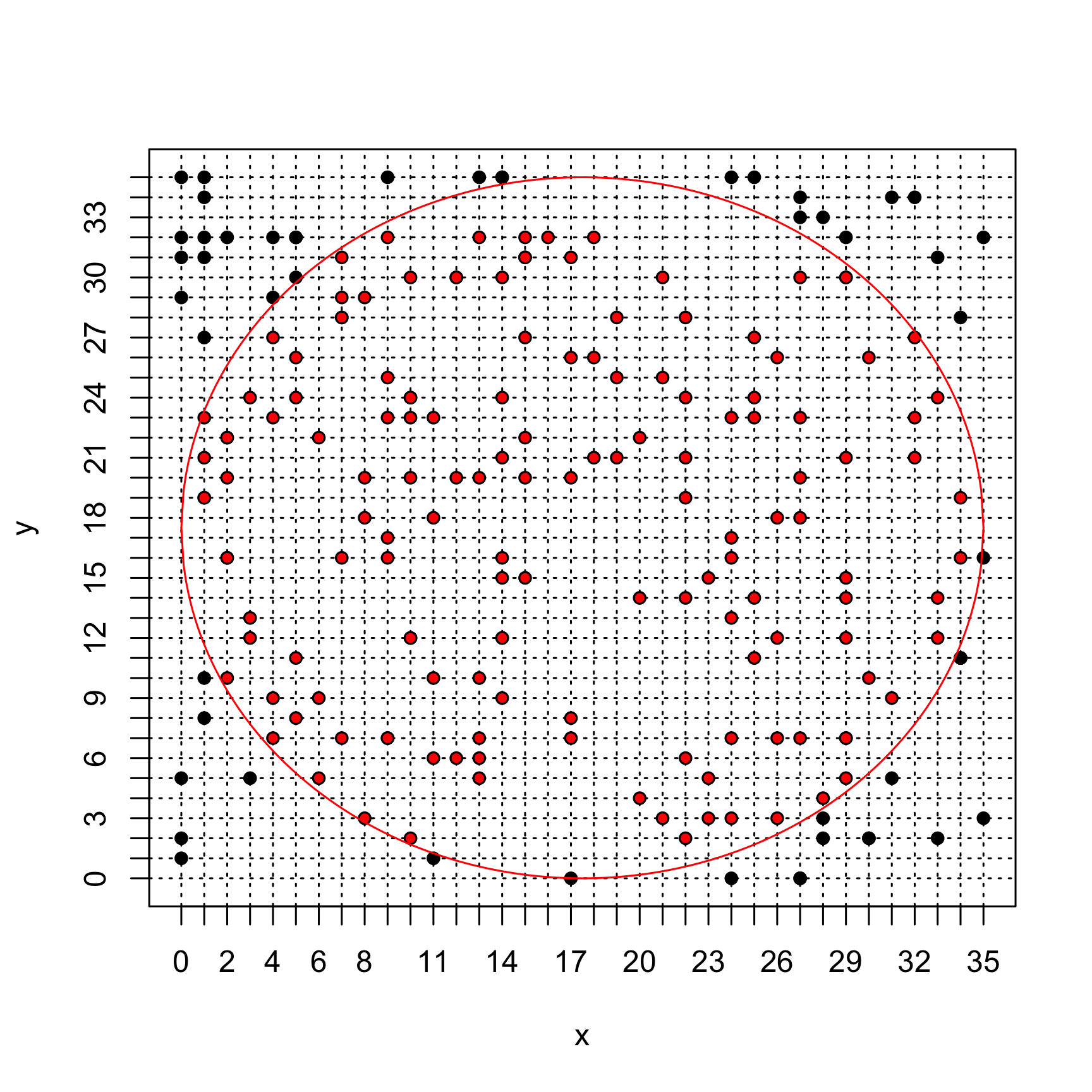Exercise 2: Monte-Carlo
The Law of Large Numbers and Monte-Carlo Estimation.
Write a function which generates a sample of
var()function).var_est <- function(n = 10) { s <- rnorm(n, mean = 2, sd = 3) return(var(s)) }Use the the Monte-Carlo method to estimate the variance of the distribution generating this sample, by using multiple realizations (e.g. 5) of the standard-deviation estimate implemented above. Do it again with 1,000 realizations, thus illustrating the law of large number convergence.
# Monte-Carlo method nMC <- 5 # Monte Carlo sample size varMC <- numeric(nMC) for (i in 1:nMC) { varMC[i] <- var_est(n = 10) } mean(varMC) # LLN estimate nMC <- 1000 # Monte Carlo sample size for (i in 1:nMC) { varMC[i] <- var_est(n = 10) } mean(varMC) # LLN estimate
Let’s now program a Monte-Carlo estimate of
Program a function
roulette_coordwhich has only one argumentngrid(representing the number of different outcomes possible on the roulette used) whose default is35, generating the two coordinates of a point (betweenRfunctionsample(whhose help page is accessible through the command?sample). The function will return the vector of the 2 coordinatesxandygenerated this way.roulette_coord <- function(ngrid = 35) { x <- sample(x = 0:ngrid, size = 1) y <- sample(x = 0:ngrid, size = 1) return(c(x, y)) }Thanks to the formula to compute the distance bewteen 2 points:
inside_disk_fun(), will have 2 arguments: the vectorpcontaining the coordinates of the points on the one hand, and the integerngridon the other hand. It will return a boolean value (TRUEorFALSE) indicating the point is inside the disk.inside_disk_fun <- function(p, ngrid = 35) { d <- sqrt((p[1] - ngrid/2)^2 + (p[2] - ngrid/2)^2) return(d <= ngrid/2) }The surface ratio between the disk (radius
TRUEif the point is indeed inside the disk andFALSEotherwise.Using the code below, generate 200 points and plot the data generated. What is the corresponding Monte Carlo estimate of
npointsand comment. How could the estimation be improved (ProTip: tryngrid <- 1000andnpoints <- 5000) ?# Grid size (resolution) ngrid <- 35 # Monte Carlo sample size npoints <- 200 # Points generation pp <- matrix(NA, ncol = 2, nrow = npoints) for (i in 1:nrow(pp)) { pp[i, ] <- roulette_coord(ngrid) } # Estimate pi in_disk <- apply(X = pp, MARGIN = 1, FUN = inside_disk_fun, ngrid = ngrid) piMC(in_disk) # Plot first we initialise an empty plot with the right size using argument plot(x = pp[, 1], y = pp[, 2], xlim = c(0, ngrid), ylim = c(0, ngrid), axes = 0, xlab = "x", ylab = "y", type = "n") ## we tick the x and then y axes from 1 to ngrid axis(1, at = c(0:ngrid)) axis(2, at = c(0:ngrid)) ## we add a square around the plot box() ## we plot the grid (using dotted lines thanks to the argument `lty = 3`) onto ## which the points are sample for (i in 0:ngrid) { abline(h = i, lty = 3) abline(v = i, lty = 3) } ## we add the sampled points lines(x = pp[, 1], y = pp[, 2], xlim = c(0, ngrid), ylim = c(0, ngrid), xlab = "x", ylab = "y", type = "p", pch = 16) ## we add the circle display x.circle <- seq(0, ngrid, by = 0.1) y.circle <- sqrt((ngrid/2)^2 - (x.circle - ngrid/2)^2) lines(x.circle, y = y.circle + ngrid/2, col = "red") lines(x.circle, y = -y.circle + ngrid/2, col = "red") ## finally we color in red the points sampled inside the disk lines(x = pp[in_disk, 1], y = pp[in_disk, 2], xlim = c(0, ngrid), ylim = c(0, ngrid), xlab = "x", ylab = "y", type = "p", pch = 16, col = "red", cex = 0.7)